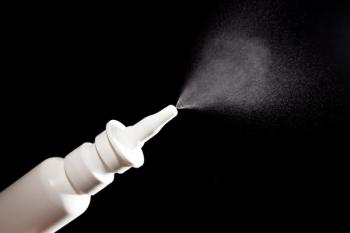Mrs Dalton, a 53-year-old, presents to the emergency department, complaining of numerous small insects that have been crawling under her skin. She has created multiple excoriations on her arms, chest, neck, legs, and face in an attempt to remove the parasites. She also complains of a larger organism in her abdomen that she can feel moving through her organs. Mrs Dalton reports that she first experienced these phenomena 1 week after watching a television program that featured a patient with similar complaints who was infected with a rare parasite. Approximately 6 months before this presentation, Mrs Dalton had traveled to a rural area of Honduras.
Mrs Dalton had previously visited her primary care physician as well as a dermatologist, a cardiologist, and 2 emergency departments to seek treatment for these complaints. Testing of substances removed from the site of her excoriations showed only skin debris. She had tried a topical antiparasitic agent to eliminate the causal organism and alprazolam to reduce anxiety associated with her symptoms, but she reports that neither medication improved her condition.
She has a history of depressive symptoms, which emerged 2 years before her current presentation. The depression had been effectively controlled for a year and finally remitted a year ago with citalopram. She has no history of psychotic or delusional complaints. She is admitted to the internal medicine service with consultation from both the infectious disease and neurology services. Workup for medical causes of this presentation include culture from the site of her excoriations; chest films; CT of the head; and laboratory tests, including complete blood cell count, basic metabolic panel, thyroid-stimulating hormone level, vitamin B12 level, folate level, urinalysis with culture, urine drug screen, and HIV screen. No evidence of a medical cause for her symptoms is detected.
Differential diagnosis
The differential includes a number of medical and psychiatric diagnoses. Several species of parasites can cause an infestation that results in pruritus and lesions caused by migrating organisms under the skin (cutaneous larva migrans).1 Possible causal organisms include Strongyloides stercoralis (roundworms), members of the genus Ancylostoma (hookworms or roundworms), and members of the genus Capillaria (nematodes). These infections are commonly seen in patients who have traveled to tropical areas as Mrs Dalton had done. Scabies (the mite Sarcoptes scabiei) can have a similar presentation.
Dermatological conditions can be associated with pruritus and subsequent excoriation, including contact dermatitis, eczema, psoriasis, and impetigo. Psychiatric diagnoses to rule out include skin picking disorder, trichotillomania, obsessive-compulsive disorder, body dysmorphic disorder, delusional disorder, or any number of conditions that could cause psychosis or delusions. Intoxication with illicit drugs such as methamphetamine and cocaine commonly leads to self-excoriation as well.
Diagnostic criteria for parasitosis include:
• Symptoms that last a month or longer that do not meet criteria for schizophrenia
• Functioning that is not markedly impaired
• Delusional periods that last significantly longer than other psychiatric symptoms, such as mania or depression if they are present
• Delusions that cannot be attributed to a medical disorder or another psychiatric disorder
Parasitosis
This disorder was first described in 1894 by Thibierge,2 who referred to it as “acarophobia.” In 1896, Perrin3 provided reports of 3 patients who presented with delusions of infestation after seeking care from dermatologists. The Swedish neurologist Ekbom’s4 description of patients with delusions of parasites crawling under their skin in 1938 is the basis of much of today’s understanding of delusional parasitosis.
Related content: 5 Techniques to Help Your Patient Accept a Difficult Psychiatric Diagnosis
Delusional parasitosis is diagnosed approximately twice as often in women as in men, and as many as 3 times as often in women older than 50 years than in men older than 50.5 Typically, the patient reports parasites crawling, living, and breeding under his or her skin for several months; the patient has previously sought help from various sources; samples of skin or other debris from the “parasites” are provided (stereotypically in a matchbox, leading to many referring to this as the “matchbox sign”); the patient has self-induced dermatological findings produced by attempts to remove the parasites.6
Diagnosis is generally made by clinical history, after the actual presence of parasites has been ruled out by careful physical examination. Other psychiatric diagnoses can be ruled out if the delusions are monosymptomatic (ie, only related to the idea of a parasitic infestation).7
Diagnosis
Given multiple negative medical evaluations and Mrs Dalton’s psychiatric presentation, delusional parasitosis-also known as Ekbom syndrome-is diagnosed. Defined by DSM-5 as delusional disorder, somatic type, this diagnosis is given to patients who have the delusional belief that they are infested with parasites. Mrs Dalton’s history is consistent with a typical presentation, including the negative workup for an actual parasitic infestation. She had already visited several health care professionals and had undergone an extensive medical evaluation before her hospitalization and diagnosis.
Techniques for improving a patient’s acceptance of a psychiatric diagnosis such as delusional parasitosis
- listen patiently to complaints about symptoms
- acknowledge that the symptoms are “real”
- refrain from challenging or validating theories about the cause of the symptoms
- carefully examine samples of “parasites” that the patient provides
Patients with delusional parasitosis have a characteristically rigid belief in their perceived infestation that often leads to involvement of nonpsychiatric health care professionals, such as dermatologists and infectious disease specialists. Neurological workup is sometimes also performed because of the link between delusions of parasite infections, ischemic brain injury, and Alzheimer disease.8,9 Patients sometimes also consult veterinarians or pest control specialists for help.
After Mrs Dalton’s admission, additional costly tests were performed, and clinicians from several different specialties were consulted. Involvement and cooperation with the psychiatry service could appropriately treat such patients and potentially reduce use of medical resources. Both the diagnostic process and prognosis can be improved if delusional parasitosis is included in the differential.
Patients with delusional parasitosis tend to resist the notion that there is a psychiatric problem underlying their symptoms. Characteristically, Mrs Dalton initially dismissed the assertion that her parasites were in fact not physically present. She became more accepting of having a mental health condition and of the need for psychiatric follow-up after much empathic discussion.
Treatment
Patients with delusional parasitosis are commonly anchored by treatment with antipsychotics. In the past, pimozide was the antipsychotic of choice for this disorder. However, recent studies have favored atypical antipsychotics, such as risperidone and olanzapine, because of their favorable adverse-effect profiles compared with older treatments. Almost all treatment recommendations include regular psychiatric follow-up for medication management and psychotherapy.
Careful counseling can ease a patient’s understanding and acceptance of parasitosis. It is important to acknowledge the seriousness of the patient’s complaints and to complete a thorough physical examination to help alleviate feelings of being dismissed as “crazy.” Additional techniques for improving a patient’s acceptance of a psychiatric diagnosis include listening patiently to complaints about symptoms, acknowledging that the symptoms are “real” without challenging or validating theories about the cause of the symptoms, expressing empathy, and carefully examining samples of “parasites” that the patient provides.
Mrs Dalton is started on a regimen 1 mg of risperidone nightly. There are no adverse effects to the medication while she is hospitalized. She is discharged with plans to follow up with the psychiatry service. She is provided psychotherapy and medication management during subsequent appointments. Within a few weeks, significant improvement is seen in the frequency and severity of the symptoms with these treatments.
Conclusion
Delusional parasitosis is an uncommon psychiatric disorder that features fixed delusions of parasites or other small organisms living under one’s skin or inside one’s body that are unrelated to a primary medical illness. It can be difficult to diagnose, and timely recognition and proper psychiatric treatment can improve quality of life and reduce medical costs. Awareness of this diagnosis is important for many health care professionals because of the many medical specialists these patients will see.
Disclosures:
Dr Czapla is PG2 Resident and Dr Tucker is Professor and Vice Chair of Education and Arnold and Bess Ungerman Endowed Chair of Psychiatry in the department of psychiatry and behavioral sciences at the University of Oklahoma Health Sciences Center in Oklahoma City. The authors report no conflicts of interest concerning the subject matter of this article.
References:
1. Meinking TL, Burkhart CN, Burkhart CG. Changing paradigms in parasitic infections: common dermatological helminthic infections and cutaneous myiasis. Clin Dermatol. 2003;21:407-416.
2. Thibierge G. Les acarophobes. Rev Gen Clin Ther. 1894;32:373-376.
3. Perrin L. On parasitophobic neurodermal diseases [in French]. Annales de Dermatologie et Syphilographie (Paris). 1896;7:129-138.
4. Ekbom KA. Derprasenile dermatozoenwah. Acta Psychiatr Neurol Scand. 1938;13:227-259.
5. Aw DC, Thong JY, Chan HL. Delusional parasitosis: case series of 8 patients and review of the literature. Ann Acad Med Singapore. 2004;33:89-94. [See pdf]
6. Lee CS. Delusions of parasitosis. Dermatol Ther. 2008;21:2-7.
7. Koo J, Lebwohl A. Psycho dermatology: the mind and skin connection. Am Fam Physician. 2001;64:1873-1878.
8. Flynn FG, Cummings JL, Scheibel J, Wirshing W. Monosymptomatic delusions of parasitosis associated with ischemic cerebrovascular disease. J Geriatr Psychiatry Neurol. 1989;2:134-139.
9. Duggal H, Singh I. Delusional parasitosis as a presenting feature of dementia. J Neuropsychiatry Clin Neurosci. 2010;22:e11-e12.















